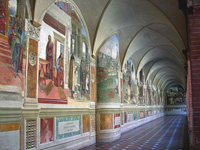| N L |
Il Sodoma, Ciclo di affreschi nel Chiostro Grande dell'Abbazia di Monte Oliveto Maggiore, Come Benedetto risalda lo capistero che s’era rotto[1]
|
Il Sodoma (Giovanni Antonio Bazzi), Frescoes in the the Great Cloister, Abbazia, Monteoliveto Maggiore
|
The Abbey of Monte Oliveto Maggiore was founded in 1313 by Bernardo Tolomei, a jurist from a prominent aristocratic family of Siena. The frescoes of the Life of St. Benedict painted by Luca Signorelli and il Sodoma in the cloister lunettes under the vaults of the the Chiostro Grande, are considered masterworks of the Italian Renaissance. The painter made certain he would be forever associated with the cycle by including this prominent self-portrait in the scene of the colander miracle (Scene 3). His depiction of himself dressed in an elegant costume with long wavy hair, turning his back on the crucial event of the scene in his eagerness to make eye contact with the viewer, goes a long way toward confirming Vasari's description of him as an impossible eccentric.(3) In his biography of Sodoma, Vasari relates that the splendid clothes the painter wears here had belonged to a nobleman, who on entering the monastery left them with the prior. The prior, in turn, presented to Sodoma. The painter promptly donned the showy costume and painted the portrait by looking at himself in a mirror - not forgetting to include his two pet badgers, a chicken and a tame raven. Giorgio Vasari also tells us that Sodoma kept a menagerie of strange animals 'so that his home resembled a veritable Noah's ark.'
|
 |
 |
 |
||
Il Sodoma, autoritratto nel ciclo di affreschi nel Chiostro Grande dell'Abbazia di Monte Oliveto Maggiore
|
|
Monte Oliveto Maggiore,
|
||
 |
 |
 |
||
|
||||
 |
 |
 |
||
|
||||
 |
 |
|||
Le storie di San Benedetto,, details of the third scene, Come Benedetto risalda lo capistero che s’era rotto
|
||||
|
||||
[1] Photo by Sailko, licensed under the Creative Commons Attribution-Share Alike 3.0 Unported license. ource: |
||||